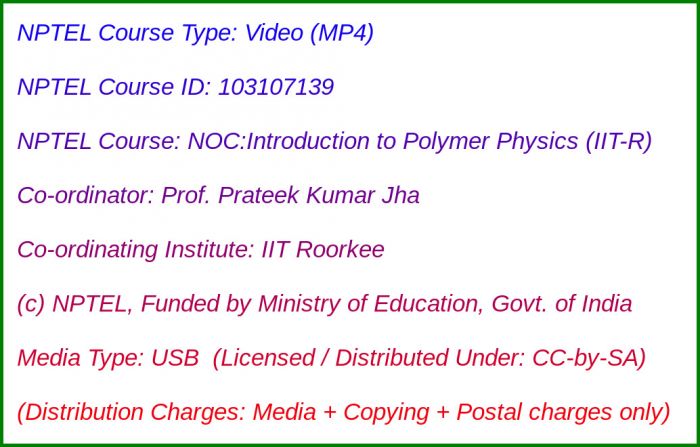NOC:Introduction to Polymer Physics (Prof. Prateek Kumar Jha) (USB)

Media Storage Type : 32 GB USB Stick
NPTEL Subject Matter Expert : Prof. Prateek Kumar Jha
NPTEL Co-ordinating Institute : IIT Roorkee
NPTEL Lecture Count : 60
NPTEL Course Size : 11 GB
NPTEL PDF Text Transcription : Available and Included
NPTEL Subtitle Transcription : Available and Included (SRT)
Lecture Titles:
Lecture 1 - Introduction to the course, Macromolecules and Life, Molecular flexibility
Lecture 2 - Classification of polymers, Types of polymerization, Average molecular weights and polydispersity
Lecture 3 - Motivation to study polymer physics
Lecture 4 - Random Walk Models of Single Chain I: end-to-end distance of a polymer chain, freely jointed chain, drunkard walk
Lecture 5 - Random Walk Models of Single Chain II: general random walk on a lattice
Lecture 6 - Random Walk Models of Single Chain III: Freely rotating chain, definition of persistence length
Lecture 7 - Models of semiflexible chains (Kratky Porod Model) - Part I
Lecture 8 - Models of semiflexible chains (Kratky Porod Model) - Part II
Lecture 9 - Probability density of an ideal chain - Part I
Lecture 10 - Probability density of an ideal chain - Part II
Lecture 11 - Entropic Elasticity, Bead-Spring Model, Simulations of random walk models
Lecture 12 - Derivation of Diffusion equation, Einstein notation
Lecture 13 - Definition of Radius of gyration
Lecture 14 - Radius of gyration for an ideal chain, concept of ideality
Lecture 15 - Nonbonded interactions, hydrophobic and hydrophilic behaviour
Lecture 16 - Definition of excluded volume; good, bad, and theta solvent
Lecture 17 - Virial expansion, Flory theory for good solvent
Lecture 18 - Flory theory for bad solvent, self-similarity and fractal nature of polymers
Lecture 19 - Derivation of fractal dimension, concentration regimes and overlap concentration
Lecture 20 - Size, shape, and structure. Gyration tensor and measures of asphericity.
Lecture 21 - Order-disorder transition
Lecture 22 - Scattering experiments, Pair correlation function
Lecture 23 - Structure of polymer chain, Introduction to Monte Carlo simulations of polymer chains
Lecture 24 - Monte Carlo algorithm: Detailed Balance, Metropolis algorithm
Lecture 25 - Practical aspects of Monte Carlo simulation
Lecture 26 - Molecular Dynamics Simulations, Review of Thermodynamics
Lecture 27 - Solution Thermodynamics - I
Lecture 28 - Solution Thermodynamics - II
Lecture 29 - Solution Thermodynamics - III
Lecture 30 - Solution Thermodynamics - IV
Lecture 31 - Phase separation regime, Introduction to lattice model of solutions
Lecture 32 - Lattice Model of Solutions - I
Lecture 33 - Lattice Model of Solutions - II
Lecture 34 - Phase behaviour of liquid solutions
Lecture 35 - Lattice models of polymeric systems
Lecture 36 - Brownian motion - I
Lecture 37 - Brownian motion - II
Lecture 38 - Brownian motion - III
Lecture 39 - Brownian motion - IV
Lecture 40 - Brownian motion - V
Lecture 41 - Rouse Model - I
Lecture 42 - Rouse Model - II
Lecture 43 - Rouse Model - III
Lecture 44 - Rouse Model - IV
Lecture 45 - Problems in Rouse Model, Hydrodynamic Interactions
Lecture 46 - Zimm Model - I
Lecture 47 - Zimm Model - II
Lecture 48 - Continuum Mechanics - I
Lecture 49 - Continuum Mechanics - II
Lecture 50 - Kuhn’s Theory of Rubber Elasticity
Lecture 51 - Elasticity of polymer network
Lecture 52 - Microscopic definition of stress tensor - I
Lecture 53 - Microscopic definition of stress tensor - II, Dumbbell model, introduction to Rouse model
Lecture 54 - Models for entangled polymeric systems - I
Lecture 55 - Models for entangled polymeric systems - II
Lecture 56 - Rheology of complex fluids
Lecture 57 - Rheometers and rheological tests - I
Lecture 58 - Rheometers and rheological tests - II
Lecture 59 - Maxwell model - I
Lecture 60 - Maxwell model - II, Closing notes

